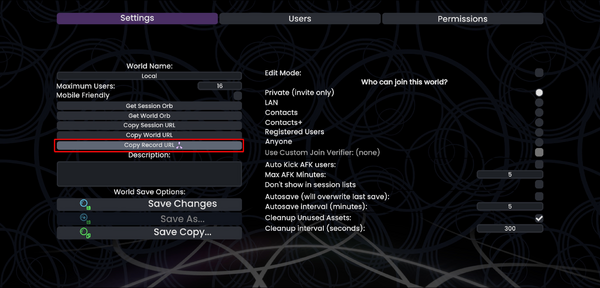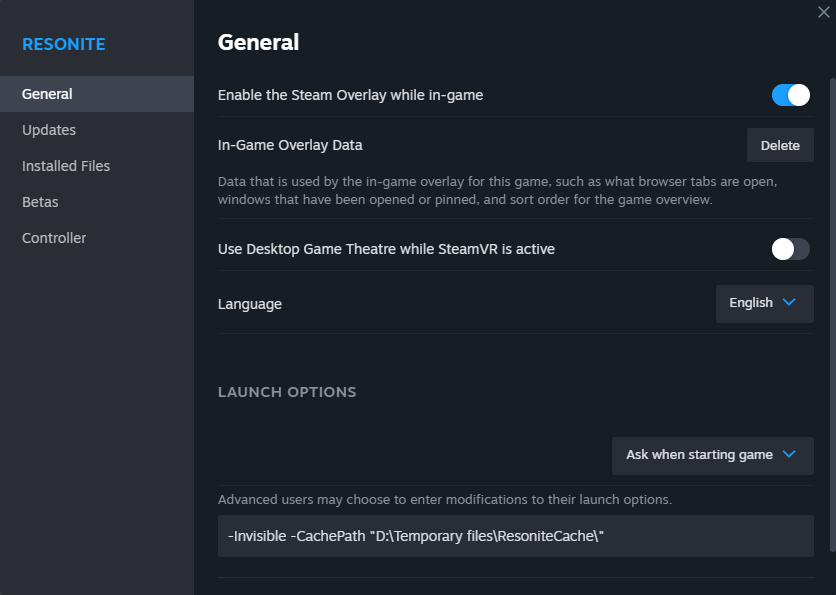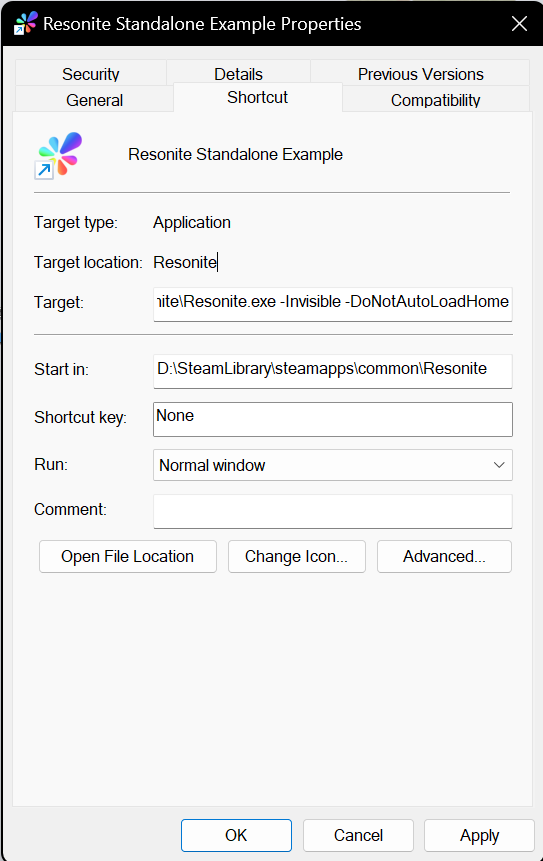Desktop builds of Resonite support several command line arguments. As Resonite is currently distributed officially through Steam, these may be set within your launch options.
These command line arguments can additionally be useful in setting up standalone experiences.
Forcing specific hardware
- none - Auto-detect hardware.
-Screen- Forces screen mode.-Device SteamVR- Forces SteamVR.-Device WindowsMR- Forces Windows Mixed Reality.-Device Oculus- Forces Oculus Rift and Touch controllers.-Device OculusQuest- Forces Oculus Quest and Touch controllers.-Device Screen360- Forces screen mode with 360° projection.-Device StaticCamera- Forces Resonite to run in a non-interactive camera mode.-Device StaticCamera360- Forces Resonite to run in a non-interactive camera mode using 360° equirectangular rendering.-LegacySteamVRInput- Forces legacy SteamVR input handling. Used as a workaround for some SteamVR devices which have a missing or bad hand skeletal model, such as Virtual Desktop used with the Oculus Quest.-ForceSRAnipal- Forces the SRAnipal SDK to initialize for HTC eye and lip tracking, even if a Vive Pro Eye is not present.-ForceBabble- Forces the Babble driver to initialize for Project Babble face tracking, even if a Babble is not running.
Joining sessions & opening worlds
-Join Auto- Automatically joins and follows active sessions on LAN on start, switching to the session with the most present users.-Join Insert_URL_or_IP:Port_here- Joins a session at the provided URI on start. (Resonite-session | lnl)-Open Insert_resrec_URL_here- Opens a world located at the provided resrec URL on start.-Scratchspace Insert_port_here- Starts a new scratchspace world on provided port. Note: Scratchspaces are a legacy feature. This argument will likely be removed in the future.-AnnounceHomeOnLAN- Starts Resonite with the Home and userspace accessible from LAN by default.-Bootstrap Insert_bootstrap_class_here- Runs a custom bootstrap function in the provided class.
Networking
-ForceLANOnly- Ensures all sessions, by default, will be announced only on the LAN network and will not be accessible from the internet.-CloudProfile- Dictates which cloud API servers are used for debugging purposes. Valid values are:ProductionStagingLocal
Drone Camera presets
These initialize the static camera with a drone script, using a specific movement preset.
-CameraBiggestGroup-CameraTimelapse-CameraStayBehind-CameraStayInFront
And also these args usable for Drone Camera.
- -UseResoniteCamera - Will spawn Static Camera as the Resonite Camera with zoom controls, preview and other functions
Common Avatar Builder
- -ForceNoVoice - CommonAvatarBuilder won't setup any avatars with voice (useful for local presentations)
Data Folders
Resonite has multiple Data Folders, these have various command line arguments to control. Make sure to read and understand Relocate Resonite Folders before using those arguments, otherwise you may experience data loss.
- -DataPath path/to/data/dir - Path to the database directory
- -CachePath path/to/cache/dir - Path to the cache directory
Logs Folder
- -LogsPath path/to/logs/dir - Redirect log files to be saved in a custom specified directory.
Synchronization Issues
There are some Command Line Arguments, that are reserved for solving synchronization issues with Resonite. These arguments can, in some cases, result in data-loss so unless you have a synchronization issue, they should not be used.
If you're having synchronization issues then see Sync Errors which has various guides on the available command line arguments and how to use them to resolve sync issues.
Database Repair
If you're having database issues then Database repair may help to resolve them.
- -RepairDatabase
Post Processing
- -ctaa - Enables ctaa (Cinematic Temporal Anti-Aliasing)
- -ctaaTemporalEdgePower Insert_Number_here - Sets ctaa's TemporalEdgePower
- -ctaaSharpnessEnabled Insert_True_or_False_here - Sets whether ctaa's Sharpness is Enabled
- -ctaaAptiveSharpness Insert_Number_here - Sets ctaa's ctaaAptiveSharpness amount
Misc
- -Watchdog Insert_filepath_here - Resonite will periodically write current time into given file. This can be used to restart the process when it freezes
- -LoadAssembly Insert_path_here - Loads extra CLR assembly into the Resonite process
- -Kiosk - Will run Resonite in Kiosk mode (hides the Userspace items such as logo and world switcher and disables teleporting for guests by default)
- -NoUI - Hides the Userspace UI
- -CubemapResolution Insert_resolution_here - Force the 360 equirectangular rendering to use this resolution for the cubemap
- -DoNotAutoLoadHome - Won't automatically load your cloud home on start (can still load manually). Alternatively can be set in Settings#Favorites for the per-user setting.
- -ResetDash - Resets the layout of the dash to the default configuration.
- -SkipIntroTutorial - Prevents the intro tutorial from starting
- -Forceintrotutorial - Forces the intro tutorial to run
- -Invisible - Force your online status to be invisible on login.
- -EngineConfig Insert_filepath_here - Specifies a custom config file.
- -BackgroundWorkers Insert_number_here - overrides the number of background worker processes. WARNING: Don't use this unless you really need to, things could break!
- -PriorityWorkers Insert_number_here - overrides the number of priority worker processes. WARNING: Don't use this unless you really need to, things could break!
- -ForceReticleAboveHorizon - Disallows looking below the Horizon for desktop when in first person by default.
- -Verbose - Produces more detailed logs during engine initialization, useful for plugin developers and debugging.
- -GeneratePrecache - Causes cloud records to get cached to
(Resonite install folder)/RuntimeData/PreCachein addition to the normal cache location. - -ExportDatabaseAll Insert_path_here - Will export everything found in the local database, this includes user and group records that have been saved on the given machine.
- -ExportDatabaseMachine Insert_path_here - Will export records specifically owned by the local machine, such as local worlds and settings.
- -ValidateTypes - Internally checks and logs if all loaded DataModel types pass DataModel validation tests.
- -NeverSaveSettings - Prevents settings from being saved and synced, useful for testing purposes and on prerelease builds.
- -NeverSaveDash - Prevents dashboard changes from being saved and synced, useful for testing purposes and on prerelease builds.
- -DisablePlatformInterfaces - Disables all platform interfaces. This includes things like Discord and Steam rich presence, but also includes platform interfaces such as the clipboard manager. This argument essentially stops Resonite from advertising itself to the host system completely.
Resonite Custom Protocol Handler (Steam only)
Resonite registers a custom protocol handler with your computer on installation. You can use this to create links which will open Resonite to a set location or world when they are clicked. These arguments are given to the Resonite launcher, which will make sure Resonite is launched and running and forward them to the running instance.
- Resonite:?world=Insert_URL_here - Open a world or session at given URL
- For example Resonite:?world=resrec:///U-ProbablePrime/R-9ce872e1-ffb8-4194-bb91-3d3ab5f157a1 - Will Open "The Directory" by ProbablePrime
- And for Sessions Resonite:?world=Resonite-session://eea1442e-0ff2-4d6a-ad16-2dac9ea786fc will join session eea1442e-0ff2-4d6a-ad16-2dac9ea786fc
The URL of a world can be accessed by opening the inspector for a world orb and navigating to the WorldOrb component or by using the Session menu's "Copy Record URL" button:
The URL field can be selected by double clicking into the field. The URL text can be copied to the Windows clipboard via Ctrl+C.
When linking to a world on a platform that restricts the clickability protocol handlers, you can use the redirect junction located at https://api.resonite.com/open/ instead. They will redirect to use the above Resonite: protocol handler.
- https://api.resonite.com/open/world/Insert_ID_here - Open a world at given URL
- For example https://api.resonite.com/open/world/U-ProbablePrime/R-9ce872e1-ffb8-4194-bb91-3d3ab5f157a1 - Will Open "The Directory" by ProbablePrime
- https://api.resonite.com/open/session/Insert_ID_here - Open a session at given URL
- For example https://api.resonite.com/open/session/S-eea1442e-0ff2-4d6a-ad16-2dac9ea786fc will join session S-eea1442e-0ff2-4d6a-ad16-2dac9ea786fc
Re-register the Protocol Handler
If you have moved your game install or if the protocol handler is no longer registered, you can manually trigger the setup process.
- Open a terminal window
- Navigate to your game install folder, then into Tools\ResoniteProtocolHandler
- Run
ResoniteProtocolHandler.exe setup - You will see "Registration successful!" if everything worked correctly
How to use command line arguments
Below are three methods for launching Resonite using command line arguments.
Each example explains how to combine the -Invisible and -CachePath Insert_path_here commands. Here the examples show how to specify a non-default cache location at D:\Temporary files\ResoniteCache\.
Choosing the best method to use depends on how you normally launch Resonite. For most users, the setup described in #Launching from Steam is likely the best choice.
Launching from Steam
- Open Steam
- Right click on Resonite in your library
- Select "Properties" and then "Set Launch Options".
- Enter the command you need to use, exactly as it appears above and Run Resonite.
Now, if Resonite is launched via Steam, the custom command line arguments will take effect.
Commands entered via this method will not take effect if Resonite is launched any other way, such as directly launching the Resonite.exe.
For the Standalone build
Use a shortcut
It is possible to use launch commands via a custom shortcut targeting the Resonite.exe file.
To create a shortcut:
- Find the Resonite install folder and right-click on the Resonite.exe.
- In the context menu click 'Create Shortcut'
- Move the 'Resonite.exe - Shortcut' file to somewhere more convenient (such as the Desktop).
- Right-click on the shortcut file and click 'Properties' in the context menu.
- This opens a dialog window. Select the 'Shortcut' tab.
- In the 'Target' text box add a space after the Resonite.exe filepath and then add your command line arguments.
- Click 'Apply' and 'OK'.
Now, if Resonite is launched by double clicking on the shortcut it will launch using the custom options. These will not be applied if a different method is used to start Resonite.
Examples
Here we're providing some example Command Line Argument setups and describing what they can do:
- Single world experience - Use command line arguments to setup a single world experience version of Resonite. Useful for conventions and exhibitions.
- Automatically join a session - Use command line arguments to create a copy of Resonite that automatically joins a session on launch. Useful for classrooms, meetings etc.


